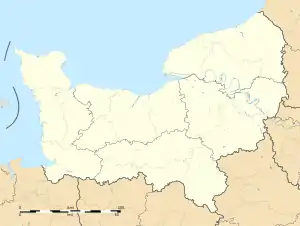Saint-Pierre-Bénouville | |
|---|---|
Location of Saint-Pierre-Bénouville | |
 Saint-Pierre-Bénouville  Saint-Pierre-Bénouville | |
| Coordinates: 49°44′29″N 0°58′18″E / 49.7414°N 0.9717°E | |
| Country | France |
| Region | Normandy |
| Department | Seine-Maritime |
| Arrondissement | Dieppe |
| Canton | Luneray |
| Intercommunality | CC Terroir de Caux |
| Government | |
| • Mayor (2020–2026) | Bernard Padé[1] |
| Area 1 | 8.39 km2 (3.24 sq mi) |
| Population | 366 |
| • Density | 44/km2 (110/sq mi) |
| Time zone | UTC+01:00 (CET) |
| • Summer (DST) | UTC+02:00 (CEST) |
| INSEE/Postal code | 76632 /76890 |
| Elevation | 69–148 m (226–486 ft) (avg. 130 m or 430 ft) |
| 1 French Land Register data, which excludes lakes, ponds, glaciers > 1 km2 (0.386 sq mi or 247 acres) and river estuaries. | |
Saint-Pierre-Bénouville (French pronunciation: [sɛ̃ pjɛʁ benuvil]) is a commune in the Seine-Maritime department in the Normandy region in north-western France.
Geography
A farming village situated by the banks of the Saâne river in the Pays de Caux, at the junction of the D 101 and the D 55 roads, some 12 miles (19 km) south of Dieppe.
Population
|
| |||||||||||||||||||||||||||||||||||||||||||||
| Source: EHESS[3] and INSEE[4] | ||||||||||||||||||||||||||||||||||||||||||||||
Places of interest
- The church of St. Pierre, dating from the sixteenth century.
- The church of St. Étienne at Dracqueville, dating from the twelfth century.
See also
References
- ↑ "Répertoire national des élus: les maires". data.gouv.fr, Plateforme ouverte des données publiques françaises (in French). 2 December 2020.
- ↑ "Populations légales 2021". The National Institute of Statistics and Economic Studies. 28 December 2023.
- ↑ Des villages de Cassini aux communes d'aujourd'hui: Commune data sheet Saint-Pierre-Bénouville, EHESS (in French).
- ↑ Population en historique depuis 1968, INSEE
Wikimedia Commons has media related to Saint-Pierre-Bénouville.
This article is issued from Wikipedia. The text is licensed under Creative Commons - Attribution - Sharealike. Additional terms may apply for the media files.